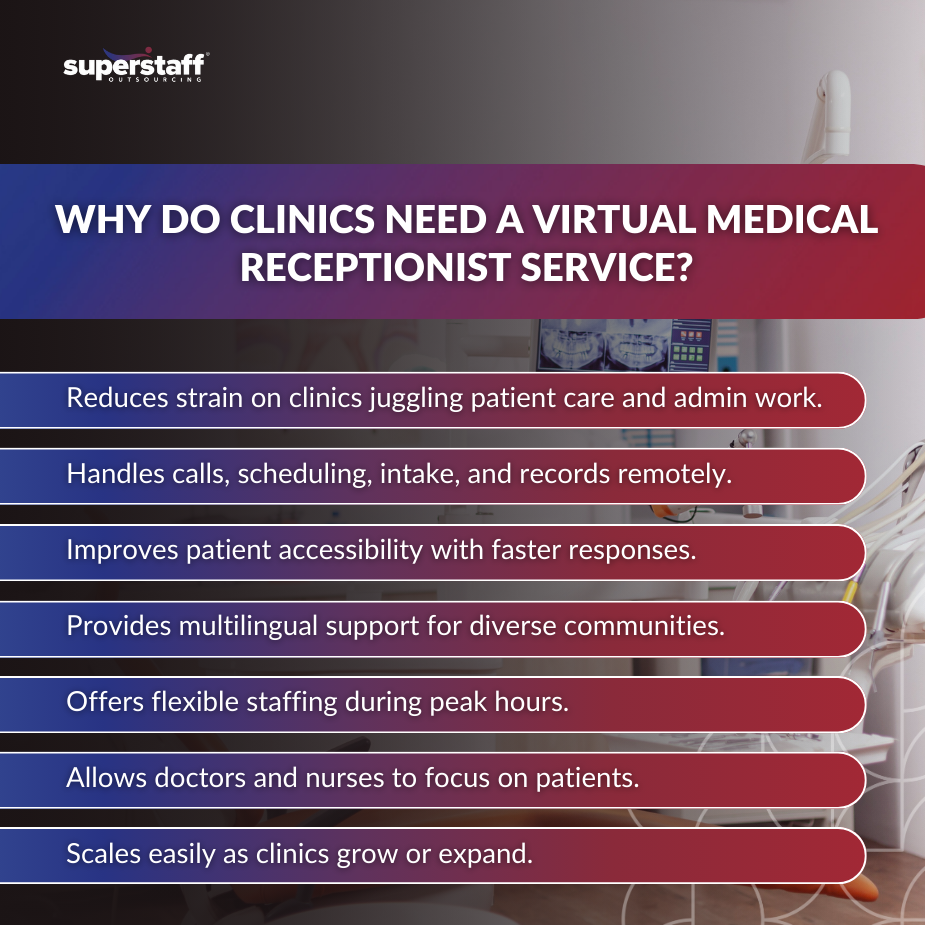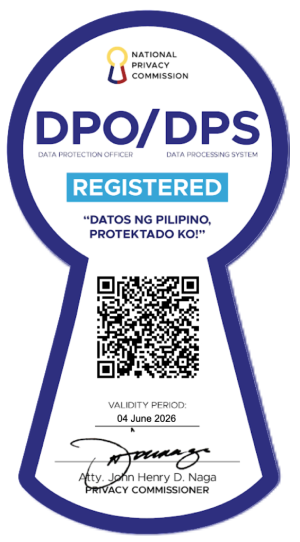
Running a clinic today means balancing two equally demanding priorities: providing quality patient care and keeping up with endless administrative tasks. From fielding nonstop phone calls to managing appointment scheduling, front desk teams are stretched thin, leaving doctors and nurses pulled into work that takes them away from patients. This growing strain has pushed many healthcare providers to seek smarter solutions that can relieve the pressure without compromising service.
A virtual medical receptionist service steps in as that solution. Instead of relying solely on in-house staff, clinics can now partner with remote professionals who handle everything from patient intake to scheduling, insurance verification, and follow-ups. With technology making it possible to manage front desk operations virtually, this approach has become increasingly relevant—especially as healthcare shifts toward digital and hybrid care models.
For clinics that want to improve patient experiences, reduce costs, and streamline day-to-day operations, a virtual medical receptionist is no longer a luxury. It is becoming an essential part of running a modern practice. This blog will answer the question “What is a virtual medical receptionist service?”, outline how it works and why more and more clinics are turning to it as a sustainable way to manage growth and patient expectations.
A Virtual Medical Receptionist Service Is the Modern Extension of a Clinic’s Front Desk
A virtual medical receptionist service functions as an off-site extension of a clinic’s front desk. These professionals perform many of the same duties as traditional in-house receptionists, but instead of sitting physically in the office, they work remotely with the help of secure communication systems and healthcare technology platforms.
Their responsibilities cover the essential administrative functions that keep a practice running smoothly: answering phones, managing appointments, coordinating patient intake forms, updating records, and even handling insurance-related queries. In many cases, virtual receptionists can also send reminders, manage follow-up communications, and support telemedicine scheduling.
The difference between a virtual and an in-house receptionist lies in flexibility and scalability. While a traditional front desk employee is limited to on-site availability and fixed hours, a virtual medical receptionist can provide coverage across time zones, during extended hours, and even 24/7 if the clinic requires it. This flexibility ensures that patients receive consistent service without the constraints of staffing shortages or office hours.
With this definition clear, the next step is to understand why clinics, particularly smaller practices under increasing operational and financial pressures, are embracing this model as a lifeline.

Clinics Are Under Pressure to Do More With Fewer Resources
Healthcare providers are no strangers to resource challenges. Rising patient volumes, staffing shortages, and administrative burdens are pushing clinics to their limits. The modern clinic often operates with fewer staff than needed, leaving those who remain stretched thin. This strain is particularly acute at the front desk, where staff are expected to manage endless calls, check in patients, handle billing inquiries, and keep records up-to-date—all at the same time.
This high-pressure environment often results in burnout and turnover among reception staff. Constant interruptions, long hours, and unrealistic expectations create a cycle where employees leave, and clinics are forced to hire and train replacements—a costly and disruptive process.
Beyond turnover, traditional reception setups come with hidden expenses. Salaries are just the beginning; clinics must also account for benefits, training costs, sick leave, and office space. These add up quickly, especially for small to mid-sized practices operating with tight margins.
Patients, meanwhile, are growing more demanding. They expect faster responses, shorter wait times, and flexible communication channels like phone, email, or even live chat. Long hold times or missed calls can frustrate patients enough to consider switching providers.
Given these realities, clinics are beginning to ask a fundamental question: is there a more efficient and cost-effective way to manage front desk responsibilities? The answer increasingly points toward adopting a virtual medical receptionist service.
Virtual Receptionists Enhance Patient Experience Through Better Accessibility
For most patients, the first impression of a clinic isn’t with the doctor—it’s with the receptionist. That initial phone call, appointment booking, or inquiry sets the tone for the entire care experience. A missed call or long hold time can leave patients feeling undervalued, while prompt, courteous service builds trust and confidence.
A virtual medical receptionist enhances this first impression by ensuring patients always reach someone knowledgeable and responsive. Unlike in-house staff who may be juggling multiple tasks at once, virtual receptionists are dedicated to handling communications, which means reduced wait times and fewer missed calls.
Appointment scheduling also becomes more efficient. Virtual teams can manage online calendars in real-time, sending confirmations and reminders that reduce no-shows and keep patient flow steady. Patients appreciate the ease and responsiveness, and clinics benefit from better schedule management.
Another often-overlooked benefit is multilingual support. Many clinics serve diverse communities, and a virtual medical receptionist service can provide staff fluent in multiple languages. This ensures patients can communicate comfortably, fostering inclusivity and deepening trust.
While the patient perspective highlights accessibility and satisfaction, the clinic itself stands to gain even greater operational advantages from virtual receptionists.
Clinics Gain Operational Efficiency and Cost Savings With Virtual Medical Receptionist Services
One of the most compelling reasons clinics turn to virtual solutions is the opportunity for significant cost savings. Running a physical front desk requires investments in salaries, benefits, office space, equipment, and training. In contrast, outsourcing to a virtual medical receptionist service eliminates many of these expenses.
Virtual receptionists work remotely, meaning clinics no longer need to allocate physical space or maintain additional infrastructure. The service is also highly scalable, allowing clinics to adjust coverage as needed—whether during peak patient hours or seasonal demand increases. This flexibility prevents overstaffing during slow periods and understaffing during busy times.
Technology integration adds another layer of efficiency. Virtual receptionists can connect directly with electronic health record (EHR) systems, appointment scheduling platforms, and communication tools. This reduces manual entry errors, keeps patient records up-to-date, and ensures a seamless flow of information across the clinic.
Ultimately, the operational and financial benefits of working with a virtual medical receptionist extend far beyond cost savings. These efficiencies directly contribute to better patient outcomes and a more focused clinical team.
Virtual Receptionists Allow Medical Staff to Focus on What Matters Most—Patient Care
The greatest advantage of a virtual medical receptionist service isn’t just reduced costs or streamlined operations—it’s the ability to give time back to medical staff. By outsourcing administrative duties, clinics free their doctors, nurses, and on-site staff from distractions that keep them away from patients.
For physicians, this means more time spent diagnosing, treating, and counseling rather than answering phones or chasing paperwork. For front-office teams, it reduces constant interruptions, allowing them to focus on in-person patient interactions. The ripple effect is a calmer, more organized clinic environment where staff are less stressed and more engaged in patient care.
This shift also improves work-life balance. In-house employees experience fewer late nights catching up on administrative backlogs, while virtual receptionists ensure tasks continue flowing smoothly in the background. The result is a more sustainable work environment that benefits both staff and patients.
As healthcare continues moving toward digital-first care models, these advantages become even more important. The combination of patient satisfaction and staff focus is setting the stage for the future of clinic operations.
The Future of Medical Reception Is Hybrid and Virtual
Looking ahead, the future of clinic reception is not purely physical—it’s hybrid and increasingly virtual. The rise of telemedicine and digital health platforms has already changed how patients interact with healthcare providers, and front desk services are adapting accordingly.
A virtual medical receptionist plays a crucial role in this new landscape. They support telehealth appointments by scheduling, sending reminders, and managing follow-ups. They also cater to patients who prefer digital-first communication, whether through phone, email, or messaging apps.
For clinics planning to expand or open new locations, a virtual medical receptionist service provides immediate scalability without the logistical challenges of hiring and training new staff in every branch. Virtual teams can grow with the clinic, offering seamless support regardless of geography.
This model also aligns with global outsourcing trends. Many clinics in the United States, for example, choose to outsource to the Philippines because of the country’s strong English proficiency, cultural compatibility, and highly skilled healthcare support workforce. Partnering with an outsourcing provider ensures clinics gain not just cost efficiency but also reliable and professional patient-facing staff.
Summarizing these benefits, it’s clear that clinics ignoring the shift toward virtual reception risk falling behind in both patient satisfaction and operational sustainability.
Elevate Your Patient Experience With an Outsourced Virtual Medical Receptionist Service
A virtual medical receptionist service is more than a cost-cutting measure; it’s a strategic investment in patient care and clinic efficiency. By defining the role, we’ve seen how it extends the traditional front desk into a scalable, tech-driven solution. We’ve examined the pressures clinics face, the improvements in patient experience, the operational savings, and the ability to let medical professionals focus on care.
As the healthcare industry continues its digital transformation, virtual receptionists are no longer optional; they’re essential. Clinics that embrace this model today position themselves for long-term success, patient loyalty, and sustainable growth.
For healthcare leaders ready to take the next step, the question is not what is a virtual medical receptionist service, but rather: when will you make the move? Partnering with outsourcing experts like SuperStaff in the Philippines ensures access to highly trained, reliable professionals who can deliver consistent patient-focused support. The future of your clinic’s front desk is already here, and it’s virtual.






